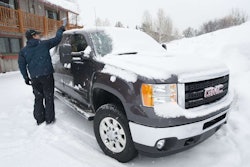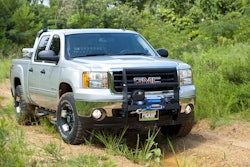No diesel fuel economy numbers
 Why aren’t fuel economy numbers listed for diesel? I’d like to know what the fuel mileage is on the new F-250/350 6.7L but it isn’t listed on the window stickers. – Henry Ruggiero, New Jersey.
Why aren’t fuel economy numbers listed for diesel? I’d like to know what the fuel mileage is on the new F-250/350 6.7L but it isn’t listed on the window stickers. – Henry Ruggiero, New Jersey.
Currently the EPA excludes vehicles with a Gross Vehicle Weight Rating greater than 8,500 pounds (or a curb weight greater than 6,000 pounds), which includes all heavy duty pickups. That said, you can expect the typical diesel pickup to get about 30 percent better fuel economy than a comparable gas-powered pickup due to efficiency alone. Our highway fuel tests show the 2011 F-250 Super Duty 6.7L Crew Cab 4×4 gets 19.6 mpg at 70mph and 14.7 mpg in town. Those unladen figures should be representative of real-world operation. The Editors.
Diff cover test – any volunteers?
Aftermarket rear diff covers from Mag-Hytec, AFE, ATS, PPE, Oasis, etc. have been on the market for at least a decade. Why hasn’t there been a full comparison test for all the variations? It’s about time to provide some hard answers regarding which cover provides the best performance. – Baron Lowe
Heat is one of the two big reasons to upgrade a cover, but preventing holing is the biggest concern. Measuring heat in an application like this would be difficult. If one really wanted to test them, a “smash test” – applying a load to the area between the centerline and bottom bolt where it would hit stumps or rocks – would be interesting. Then we could see which one held up the best. We’ve got the stumps. Any volunteers?
Half-ton diesel update
It’s a question we get frequently and never seems to go away – when are the truck manufacturers going to give us a diesel to go in their half-ton trucks? The answer, we think, might be just around the corner.
With the new CAFÉ standards announced this year automakers may not be able to meet the new standards without increasing the diesel engines in their fleets. The standard for light trucks is 30 mpg by 2016 – a hard slog, and maybe impossible without diesel or hybrid or both.
Diesel car sales are up 38 percent with the introduction of the VW Jetta TDI and Chevrolet recently announced it will offer a diesel Chevy Cruze in 2014, so it’s apparent there’s a demand for the more efficient engine.
Cummins has been working on a research project with Nissan and the Department of Energy to study the feasibility and impact of a “next generation” V6 diesel in a half-ton pickup that can improve fuel economy 40 percent over a comparable V8 gas burner. If you’re drooling for details you can find a report at: https://www1.eere.energy.gov/vehiclesandfuels/pdfs/merit_review_2011/adv_combustion/ace061_ruth_2011_o.pdf
Causes of tire chunking
 My Michelin LTX M/S 2 tires have 49,000 miles on them and are starting to experience slight chunking. Any ideas as to why? My care of the tires was borderline anal, picking small rocks out of the sipes and checking pressure frequently with my expensive gauge. They’re on a 2003 Chevy Silverado with a 5.3L V8 engine.
My Michelin LTX M/S 2 tires have 49,000 miles on them and are starting to experience slight chunking. Any ideas as to why? My care of the tires was borderline anal, picking small rocks out of the sipes and checking pressure frequently with my expensive gauge. They’re on a 2003 Chevy Silverado with a 5.3L V8 engine.
– Darick Pash
Michelin has not responded to our queries so we’ll have to settle for a generic answer, Darick. Chunking most frequently occurs in racing vehicles, on hot tires or when underfoot conditions simply rip out pieces of rubber. Small rocks and gravel can also get stuck in the sipes in the tread and if the tire’s normal flexing doesn’t push them out, they can eventually weaken the tread around them. The tread blocks are designed to flex in a certain direction and if they’re forced to flex in a different direction, like the extreme lateral forces put on a race car tire in a fast corner, you get tread chunking. A rubber compound that’s too hard for the application or underfoot conditions may also suffer from chunking. So Darick, unless you’re a NASCAR wannabe, or you have the wrong tires for what you do, you might be looking at a manufacturing defect. And you might have a warranty claim although at 49,000 miles, you’d be cutting it close.
New HD GM Wheels
Did GM change the wheel lug pattern on the 2011 HD 2500/3500? – Sid Parks
Yes they did. Chevy and GMC went from the 8-0n-6.5-inch pattern to a more robust 8-0n-180mm. That’s good news for the aftermarket wheel manufacturers—not so good for those of us who like to move nice wheels from older pickups to our new ones. It also limits what styles of wheels are available until the aftermarket catches up.
GOT QUESTIONS?
Send them to Bruce Smith at [email protected]







